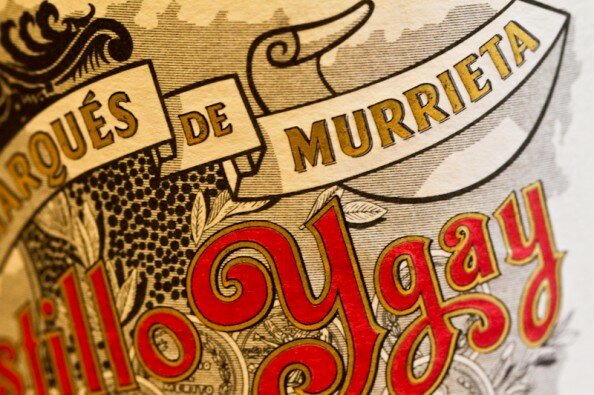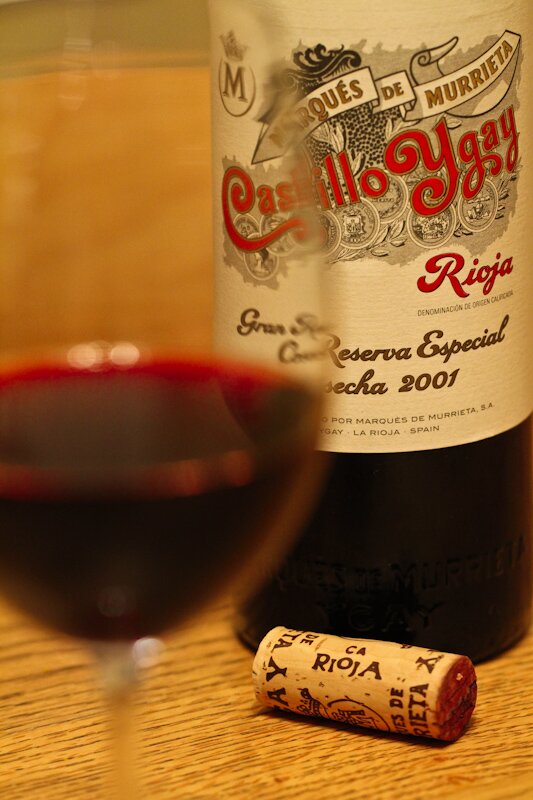
Tag Archives: Spain
Castillo Ygay Gran Reserva Especial
Every now and again, a dreary weekday comes along and begs for some wine to improve it. Great wine – or even just expensive wine – can often create the feeling that it requires times of occasion for opening. But on those days that are less than stellar, that wine can be an occasion in and of itself.
Tonight, it’s a Rioja, Castillo Ygay Gran Reserva Especial from the 2001 vintage, a year that was regarded favorably in the wine press. I’d never even heard of the wine let alone tasted it, but I bought a bottle on recommendation from Elie in Royal Oak.

Blood red with barely a hint of browning from age, it’s youthful despite its 10 years of life. And that shows on the nose: While it displays some rustic, meaty qualities, it’s initially a bit closed. Eventually, it opens up to show some tart raspberry jam aromas. Similarly, it starts out quite tannic, though not so much so as to be unenjoyable. Quite the opposite. There are hints of a minty Bordeaux quality and rough, oaky flavors along with plenty of fruit. Over time, layers build: licorice, plums, berries, spices.
All the somewhat superfluous wine media jargon and descriptors aside, this is delicious, dry, meat-friendly, powerful, age-worthy wine. “Masculine” in its youthful astringency and “feminine” in its somewhat mainstream elegance.
It stands in marked, stark contrast to a lot of the rustic wine I drink on a regular basis, but I find it captivating.
Ygay is only made in the “best” years in Rioja — 1978, 1998, 2001, etc — using 93% Tempranillo and 7% Mazuelo from the producer’s prime vineyard sites. It ferments in stainless undergoing daily remontage (circulating the wine from bottom to top of the vat) and pigeage (punching the “cap” of grape skins down into the wine) to ensure lots of skin contact, and undergoes at least 10 months of aging in new oak.
The 2001 spent a few additional years in older barrels and then spent another 3 years in the bottle before being released to the market. (The 1978 spent 18 years in the barrel before moving to the bottle!) These guys clearly are in no rush to get their product to market.
As I’m writing this tasting note, I’m finishing the last of the bottle, and there’s a strong acidity at the finish. It’s remarkable how much this has changed after 100 minutes or so and how many different aspects there are to this wine.
I often talk about how much I dislike oak, but while that flavor is present, it’s done so very thoughtfully here — and it’s where I find myself really puzzled by this wine. The barrel is present, but it’s not as though it’s overpowering, despite all the time in American oak, widely used in Spain and known for contributing powerful vanilla flavors. There’s barely a whiff of vanilla here. With age, that oak has already settled out or been buried behind all this tannin, and there’s at minimum another decade of improvement in this bottle.
This quite successfully walks a thin line between a fruity, oaked, international style of wine and a traditional Rioja with a pure red color and big, burly tannins. There’s no hint of purple hues in the glass or vanilla extract aromas in the nose, but they’ve managed to get intense extraction and fairly high alcohol (14%-ish). It sees new oak, but by the time it hits the market, most of that flavor is gone. It’s kind of a paradox, but it’s a fun paradox to unravel and enjoy on a rainy Monday night.
If you’re in the mood for a bit of a splurge but a lot of age-worthy bang for your buck, consider picking this up. It’s a delicious bottle.

Book. Cover. Judge. Alion.
On the surface, it’d be easy to dismiss Vega Sicilia. It’s a big-name winery that scores big points, and the company manages several sub-brands, often signs of a corporate juggernaut that simply produces wines out of a test tube that fit certain perceived market price points.
The most recent brand is Alion, which is managed more scientifically to be drunk younger. Not really the sign of a wine that I’d be excited to try. I sometimes judge a book by a cover — or at least I sometimes pre-judge wine.
Except here’s the thing: It’s pretty damn good.
Alion is 100% Tempranillo, aged in 100% new oak, so it’s a robust wine. But it’s in the barrel for four years, and even the younger vintages are fairly accessible upon release. Retail is around $60, and I don’t know that I’d routinely pay that much for this wine — there are far, far more special wines for less money — but it’s an enjoyable drink. And I happened to receive an older vintage as a gift in the past few months as well, so this past week, we did a little tasting…
- Alion 2004 – Lots of cherry and plum. A very fruity wine without ever verging on sweet. The finish is really, really long. There’s a lot of tannin here, though it’s not wildly astringent. More woody or herbal. Plenty of oaky wines have pushed me away from contemporary wine making, but if every “manipulated” wine were this good, I’d have little problem with it. It’s a very broad sip of wine that really gets itself into every corner of your palate. I purchased this bottle from Elie Wine Company in Royal Oak.
- Alion 1996 – Supposedly all the higher-end Vega Sicilia wines like Unico receive a pretty traditional and rigorous treatment from vine to bottle — low yields, multiple harvests, long aging in older barrels, et cetera. I can’t find any information online about harvests at Alion, which is in a different location from Vega Sicilia itself, but if this vintage is any indication, they’re doing something right. This wine has years left on it, but it’s open and full of cool stuff even now. There’s some toasty oak qualities that are subtle and pleasant. There’s still a lot of fruit, though it’s gotten a bit more acidic and much less jammy than the 2004. A really very elegant wine and a hell of a nice gift.
Dry Sherry Amor

“Enough,” he said; “the cough is a mere nothing; it will not kill me. I shall not die of a cough.”
“True — true,” I replied; “and, indeed, I had no intention of alarming you unnecessarily — but you should use all proper caution. A draught of this Medoc will defend us from the damps.”
Here I knocked off the neck of a bottle which I drew from a long row of its fellows that lay upon the mould.
“Drink,” I said, presenting him the wine.
He raised it to his lips with a leer. He paused and nodded to me familiarly, while his bells jingled.
“I drink,” he said, “to the buried that repose around us.”
“And I to your long life.”
Until a few years ago my sole exposure to sherry came via the pages of an Edgar Allan Poe short story wherein Montresor lures his fellow noblemen Fortunato into the catacombs of his palazzo with the promise of sampling from a rare cask of Amontillado. It’s a story of revenge, memorable for a tight, driven plot and insights into character rarely found in the short fiction genre. Though I have always wondered what that cask might have contained.
It was at lakeside gathering of friends that I had my first taste. Putnam Weekley passed around appetizers of sardines and almonds to pair with tastes of Tio Pepe Fino. He offered it again once at his house. I admit I wasn’t impressed. It tasted narrow and odd but not forgettable.
Months later it came to me suddenly. At Michael Symon’s Roast Restaurant in downtown Detroit where the clouds parted and heavenly light shone on a post-meal Palo Cortado. The seal was broken. I purchased several bottles of Tio Pepe in the summer months with a newfound appreciation and subsequently pushed full glasses towards my closest friends. I’ve heard that Fino is an even better match for raw oysters than Muscadet. I look forward to testing this for myself.
As the days shorten I’ve turned to bottles of Lustau Los Arcos dry Amontillado. I buy this brand mainly because the wine stores I frequent don’t offer much else in the way of sherry. The others are either cheap swill for $5.99, or semi-dry, or both. I’m not complaining. Lustau is a fine drink of sherry. With a nose of raisins and dried leaves and a rich, nutty flavor tempered by a bracing acidity it pairs well with everything from nuts and cheese to root vegetable stew. It is a most food-friendly wine. I could drink a bottle in a sitting though 17%ABV tends to make me feel a little funny. But I generally throw the bottle in the refrigerator, where it keeps, opened, for weeks. I occasionally take a nip while cooking dinner. Plus, it makes a fantastic pan sauce and works well in Asian stir-fry gravies and various soups beyond the classic French onion.
Evidently, there’s a marketing plan in the works to get folks drinking sherry again. But as Dr. Vino describes, considering its reputation and the sort of intense flavors that are alien to most wine drinkers, it’ll be an uphill push. It is said that it takes a full ten tries before one acquires a taste for olives. Yet you’ll find that just about every decent market now offers a self-serve olive bar with several varieties these days. If my own experience is any measure, it should only take a few drinks in the right setting to grow a sherry drinker.
My own humble palace has no catacombs nor a rare cask of Amontillado, and I don’t want to kill you (probably). But follow me inside anyway, there might be a glass of sherry waiting for you.